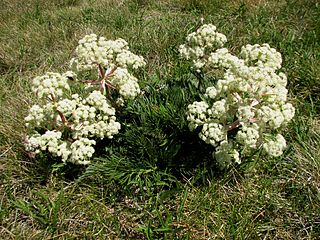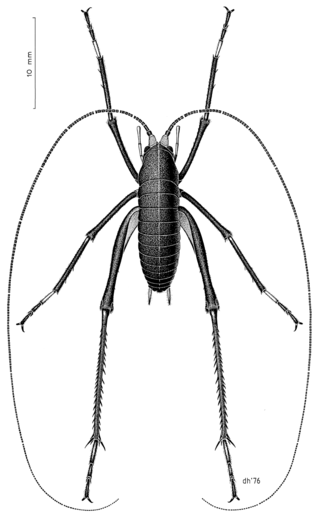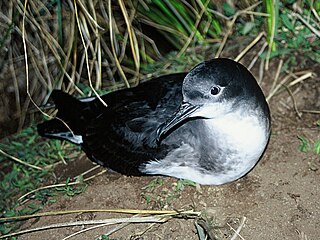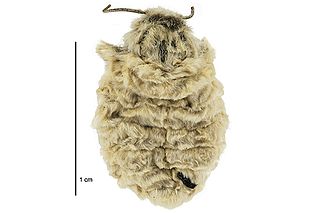
The Curculionidae are a family of weevils, commonly called snout beetles or true weevils. They are one of the largest animal families with 6,800 genera and 83,000 species described worldwide. They are the sister group to the family Brentidae.

The pipits are a cosmopolitan genus, Anthus, of small passerine birds with medium to long tails. Along with the wagtails and longclaws, the pipits make up the family Motacillidae. The genus is widespread, occurring across most of the world, except the driest deserts, rainforest and the mainland of Antarctica.

Aciphylla is a genus of about 40 species of herbaceous plants in the family Apiaceae, all but two of them endemic to New Zealand. They range from small cushion plants to tall flower spikes surrounded by rosettes of stiff, pointed leaves, the latter probably adaptations to prevent browsing by moa. Their common name is speargrass or Spaniard. Most Aciphylla species live in subalpine or alpine habitats in the South Island. Fragrant oil extracted from some large species, known as taramea, is still used as a perfume by Māori.

Asteliaceae is a family of flowering plants, placed in the order Asparagales of the monocots.

The Coelopidae or kelp flies are a family of Acalyptratae flies, they are sometimes also called seaweed flies, though both terms are used for a number of seashore Diptera. Fewer than 40 species occur worldwide. The family is found in temperate areas, with species occurring in the southern Afrotropical, Holarctic, and Australasian regions.

Macropathus is a genus of cave wētā in the family Rhaphidophoridae, endemic to New Zealand.

Neonetus is a genus of cave wētā in the family Rhaphidophoridae, endemic to New Zealand. All described species are small; when adult, individuals are only about 1 cm long. Neonetus variegatus and N. huttoni are common in native and exotic forests but because they are small and nocturnal, they are often overlooked.

Pharmacus is a genus of cave wētā in the family Rhaphidophoridae, endemic to New Zealand. All species are alpine adapted and found at high elevations in the South Island. They live among rocks on high mountain ridges, often well above glaciers and vegetation. Pharmacus has a geographical range that extends from Nelson south to central Otago and Fiordland. They are small insects with a body length of approximately 14-20mm. In this genus, females are larger than males. All species exhibit dark brown to black pigmentation of the body and legs. They have a dense clothing of setae and a serrated ovipositor. When active they are lively jumpers. For example, Pharmacus montanus is known as the Mount Cook flea because of its habit of leaping out of rock crevices on to mountain climbers.

Porrhothele antipodiana, the black tunnelweb spider, is a species of mygalomorph spider that is endemic to New Zealand. It is the most common and widespread of several species in the genus Porrhothele, and is especially common in the greater Wellington region where the vagrant mature males are often encountered in or around dwellings. This species is one of New Zealand's most studied spiders. In New Zealand, the common name "tunnelweb spider" is also often used to refer to members of the genus Hexathele. Neither should be confused with their distant relatives, the highly venomous Australian funnel-web spiders.

Hutton's shearwater is a medium-sized ocean-going seabird in the family Procellariidae. Its range is Australian and New Zealand waters, but it breeds only in mainland New Zealand. Its conservation status is Endangered, because there are just two remaining breeding colonies, located in the Seaward Kaikōura Range. Six other shearwater colonies have been wiped out by introduced pigs. Hutton's shearwater is the only seabird in the world that is known to breed in alpine areas. Conservation measures for the bird include community initiatives to rescue birds that crash-land at night on streets in Kaikōura, and the establishment of a protected area on the Kaikōura Peninsula including a predator-proof fence, man-made burrows, and translocating fledglings from the remaining colonies.

Hadramphus, commonly known as knobbled weevils, is a genus of flightless molytine weevils from the family Curculionidae. It is endemic to New Zealand and consists of four species.

Metacrias huttoni is a species of moth in the family Erebidae. This species is endemic to New Zealand where it is known from the eastern areas of the South Island. The female of the species is flightless and buff coloured where as the male is brightly coloured and flies during the day.

Helastia cinerearia is a moth of the family Geometridae. It is endemic to New Zealand and can be found in the North, South and Stewart Islands as well as on the Mercury and Chatham Islands. The preferred habitat of H. cinerearia includes urban gardens, various types of forest and sub alpine habitats. The larval host is lichen on rocks. The adult moths are on the wing all year round but are most commonly observed from September until February. Adult moths are nocturnal and have been observed feeding from and likely pollinating Hebe salicifolia, Hoheria lyallii and Leptospermum scoparium.

Pinnoctopus cordiformis is a species of octopus found around the coasts of New Zealand. It is one of the most common species of octopus in the country.
Waitetola is a genus of South Pacific tangled nest spiders containing the single species, Waitetola huttoni. It was first described by Raymond Robert Forster & C. L. Wilton in 1973, and has only been found in New Zealand.

Lyperobius huttoni is a New Zealand weevil found in alpine areas of the South Island and at sea level around the Wellington coast. It feeds only on speargrass (Aciphylla). Weevils from the endangered Wellington population have been translocated to predator-free Mana Island.

Notoreas blax is a species of moth in the family Geometridae. This species is endemic to New Zealand. This moth frequents alpine habitat and can be found in the Canterbury and Otago regions.

Lyperobius hudsoni is a flightless weevil found in alpine areas of Central Otago and Otago Lakes in the South Island of New Zealand.

Lyperobius clarkei is a flightless weevil found in alpine areas of Buller and Nelson in the South Island of New Zealand.


















